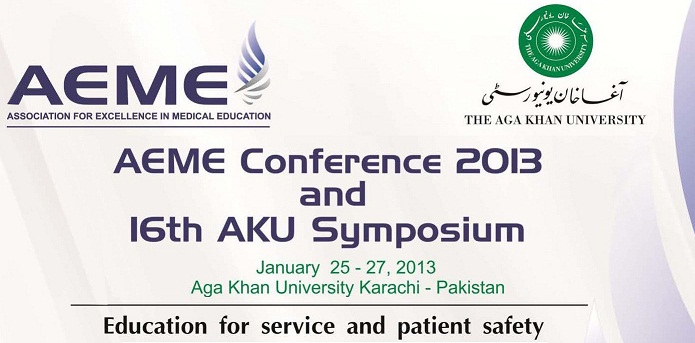Day 1 : Poster Presentations (Theme: Curricular Innovations)
Introduction of patient safety rounds: an economical approach to enhance patient safety culture at a tertiary care hospital at Karachi, Pakistan
Location
Auditorium Pond Side
Start Date
26-1-2013 10:30 AM
Abstract
Introduction: Patient safety leadership walk rounds were initiated at the Aga Khan University Hospital in the beginning of the year 2012. AKUH is a tertiary care teaching hospital at Karachi, Pakistan that aims at developing a patient safety culture that fosters change and improves clinical practice. These walk rounds serves as a tool to connect senior leaders to frontline staff as a mean to educate senior leaders of the safety issues as well as signaling frontline staff to senior leader’s commitment to safety. Aims: The aims of these safety walk rounds were to demonstrate commitment to safety, to provide opportunities for senior executives to learn about patient safety at ground level and to identify opportunities for improvement.
Methodology: Core group was formed including executive leaders, clinical chairs and nursing managers. The group conducted quarterly visits to different areas including emergency department, medical and surgical units, Labor & Delivery unit, radiology and clinical laboratory. By far a total of 20, hourly round has been conducted in these areas. The group asked questions to available frontline staff (8 to 10 on average) about adverse events and near misses and about the factors that causes such an event in the department. Events captured in the walk rounds were classified into departmental, interdepartmental and system wide or budgetary issues. Departmental heads and managers were then followed regularly by the lead patient safety nurse to update the team on the work done to overcome the identified issues.
Results: Total 153 issues i.e., 104(67.97%) departmental, 41(26.79%) interdepartmental, 8(5.22%) system wide/budgetary issues were shared. 100(65.35%) issues have been successfully resolved whereas on 41(26.79%) issues, work is in progress. However 12(7.84%) issues are still open. Conclusion: Patient safety rounds have proven to be effective tool to enhance patient safety and create a culture of openness where the staff feels comfortable in sharing their concerns fearlessly with the leaders. Therefore the hospital leaders plan to continue conducting patient safety rounds and to also initiate the walk rounds in other areas of the hospital.
Introduction of patient safety rounds: an economical approach to enhance patient safety culture at a tertiary care hospital at Karachi, Pakistan
Auditorium Pond Side
Introduction: Patient safety leadership walk rounds were initiated at the Aga Khan University Hospital in the beginning of the year 2012. AKUH is a tertiary care teaching hospital at Karachi, Pakistan that aims at developing a patient safety culture that fosters change and improves clinical practice. These walk rounds serves as a tool to connect senior leaders to frontline staff as a mean to educate senior leaders of the safety issues as well as signaling frontline staff to senior leader’s commitment to safety. Aims: The aims of these safety walk rounds were to demonstrate commitment to safety, to provide opportunities for senior executives to learn about patient safety at ground level and to identify opportunities for improvement.
Methodology: Core group was formed including executive leaders, clinical chairs and nursing managers. The group conducted quarterly visits to different areas including emergency department, medical and surgical units, Labor & Delivery unit, radiology and clinical laboratory. By far a total of 20, hourly round has been conducted in these areas. The group asked questions to available frontline staff (8 to 10 on average) about adverse events and near misses and about the factors that causes such an event in the department. Events captured in the walk rounds were classified into departmental, interdepartmental and system wide or budgetary issues. Departmental heads and managers were then followed regularly by the lead patient safety nurse to update the team on the work done to overcome the identified issues.
Results: Total 153 issues i.e., 104(67.97%) departmental, 41(26.79%) interdepartmental, 8(5.22%) system wide/budgetary issues were shared. 100(65.35%) issues have been successfully resolved whereas on 41(26.79%) issues, work is in progress. However 12(7.84%) issues are still open. Conclusion: Patient safety rounds have proven to be effective tool to enhance patient safety and create a culture of openness where the staff feels comfortable in sharing their concerns fearlessly with the leaders. Therefore the hospital leaders plan to continue conducting patient safety rounds and to also initiate the walk rounds in other areas of the hospital.


